
02. Greek Coinage by City
|
|
|

Kroisos, LydiaLydian Kingdom. Kroisos. Ca. 564/53-550/39 B.C. AR 1/12 stater (7 mm, 0.80 g). Sardes mint. Confronted foreparts of lion, on left, and bull, in right / Incuse square punch. Berk 26-7; SNG Kayhan 1020-1; Traité I 413. VF, toned.ecoli
|
|

Mithradates IIParthian Kingdom, Mithradates II 123-88 BC, Drachm, 4.16g: Obv: Diademed bust of Mithradates left Rev: Archer seated right, legend around. Sellwood 27.1. Rhagae mintecoli
|
|

Achaemenid Kingdom. Artaxerxes I to Artaxerxes IIAchaemenid Kingdom. Artaxerxes I to Artaxerxes II. Ca. 450-375 B.C. AR siglos (15.69 mm, 4.84 g). Persian king or hero in kneeling-running stance right, holding spear and bow / Rectangular incuse punch. Carradice Type IIIb; SNG Kayhan 1029. Fine, rough.ecoli
|
|

Adramyteion, MysiaAdramyteion in Mysia, 200-150 BC.,
Obv.: head of Zeus left.
Rev.: AΔP-A-M-VTHN-ΩN , horseman riding right, hand raised.
ANS 1944.100.42406 ; cf. Sear GC 3805
Adramyteion, is located on the western coast of Turkey. Today Burhaniye, it was previously named Kemer, ("aquaduct"), after a nearby aquaduct which has since been demolished. ecoli
|
|

AeginaAEGINA. 510-485 BC. AR Stater (11.67 gm). Smooth-shelled turtle / Incuse square of モskewヤ pattern. SNG.Cop.501. Toned Fine.ecoli
|
|
|

Aeolis, KymeBronze AE 16, BMC Aeolis p. 109, 57, VF, Kyme mint, head of Amazon Kyme right; reverse forepart of galloping horse right, vase behind, KY above, magistrate name LESBIOS below
ecoli
|
|

Aeolis, KymeAEOLIS, Kyme. 6th century BC. AR Hemiobol. Forepart of horse right / Floral pattern. SNG Copenhagen 34; SNG Kayhan 91; SNG von Aulock 7692; Klein 334. VF, darkly toned.ecoli
|
|

AEOLIS. TemnosAEOLIS. Temnos. Ae (3rd century BC).
Obv: Head of Dionysos left, wearing ivy wreath.
Rev: T - A.
Grape bunch on vine.
SNG Copenhagen 246-8.ecoli
|
|

Aiolis, AigaiAiolis, Aigai. 3rd century B.C. AE 18 (18.3 mm, 4.01 g, 10 h). Head of Apollo right / AIΓAEΩN, Goat standing right. SNG Cop 10; SNG von Aulock 1596. aVF. Scarce.ecoli
|
|

AIOLIS, NEONTEICHOSAIOLIS NEONTEICHOS.
Helmeted head of Athena
owl on NE monogram
SNG von Aulock 1669. SNG München 598. ecoli
|
|

Aiolis, TemnosAiolis, Temnos, 350-300 B.C.
Obv: Head of Dionysos right, head wreathed with ivy.
Rx: T - A to left and right of bunch of grapes on tendrilled vine.
Cf. SG 4230
CNG Bulk Lotecoli
|
|

Aitolian League Aitolian League Æ20. Circa 205-150 BC. Helmeted head of Athena right / Herakles to front holding club and lion’s skin. Tsangari, cf. 1446. 6.23,ecoli
|
|

AkarnaniaAKARNANIA, Federal Coinage. Circa 300-167 BC. Æ . Helmeted head of Athena left / Head of a man-headed bull (Achelous) left; t. SNG Copenhagen 423; BMC Thessaly pg. 170, 21. ecoli
|
|

AKARNANIA, Ambracia360-338 BC. 20mm. Helmeted head of Athena left, name of magistrate above / Pegasus flying left, A below. SG 1962v., VF. Very pleasing late classical style. Ex-Sayles V113ecoli
|
|

AKARNANIA, Anaktorion.AKARNANIA, Anaktorion
Founding:
Kypselos & Gorgos, 7th century BC
The Corinthians sent by Cypselus and Gorgus took possession of this shore and also advanced as far as the Ambracian Gulf; and both Ambracia and Anactorium were colonized at this time. (Strabo 10,2,8)
AKARNANIA, Anaktorion. Circa 350-300 BC. AR Stater (20mm, 7.89 gm). Pegasos flying left; AN monogram below / Helmeted head of Athena left; NA[Y] to left, AN monogram and ring with pendants behind. Pegasi II pg. 504, 73. Near VF.
Ex-CNG eAuction 105, Lot: 33 116/150ecoli
|
|

AKARNANIA, LeukasAKARNANIA, Leukas. Circa 345-307 BC. AR Stater (20mm, 7.66 gm). Pegasos flying right; L below / Helmeted head of Athena left; small L and hippocamp behind. Pegasi II pg. 424, 118; SNG Copenhagen -. VF
Ex-CNG eAuction 104, Lot: 47 150/200 ecoli
|
|

AKARNANIA, LeukasAKARNANIA, Leukas. Circa 440-400 BC. AR Diobol (10mm, 0.96 g, 6h). Pegasos flying left / Pegasos standing left. Cf. BCD Akarnania 182-3 and 184.3; cf. BCD Corinth 44-6; SNG Copenhagen -. Fine, some porosity. Very rare.ecoli
|
|

Antigonos I monophthalmosKINGS of MACEDON. Antigonos I Monophthalmos. As king, 306/5-301 BC. Æ Unit (16mm, 4.56 g, 12h). Salamis mint. Struck under Demetrius I Poliorketes. Macedonian shield, boss decorated with facing gorgoneion / Macedonian helmet; kerykeion and monogram to lower left and right. Price 3159 (c. 323-315 BC); Zapiti & Michaelidou 7–8..ecoli
|
|

Apulia, ArpiAPULIA, Arpi. Circa 275-250 BC. Æ. Bull butting right / Horse galloping right. SNG ANS 641; HN Italy 645ecoli
|
|

Apulia, ArpiAPULIA, Arpi. Circa 325-275 BC. Æ Laureate head of Zeus left / Horse rearing left; star above, monogram below. HN Italy 644; SNG ANS -.ecoli
|
|

Apulia, Ausculum from Ausculum, where a battle was fought between the Roman Republic and King Pyrrhus; where afterwards the victor had famously said
to one who was congratulating him: "If we are victorious in one more battle with the Romans, we shall be utterly ruined."
Apulia, Ausculum, Æ 18mm. 3rd Century BC. Head of young Herakles left, in lion's skin, club behind neck / Nike standing right, holding wreath & palm. SNG ANS 648ecoli
|
|

Apulia, Ausculum Apulia, Ausculum, Æ 18mm. 3rd Century BC. Head of young Herakles left, in lion's skin, club behind neck / Nike standing right, holding wreath & palm. SNG ANS 648ecoli
|
|
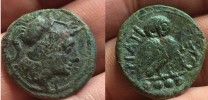
Apulia, TeateAPULIA, Teate. Circa 225-200 BC. Æ Quincunx, Head of Athena right, wearing crested Corinthian helmet; four pellets above / Owl standing right on Ionic capital; four pellets in exergue. SNG ANS 742; SNG France 1420; SNG Morcom 224 var. (pellets right on reverse); HN Italy 702a.ecoli
|
|
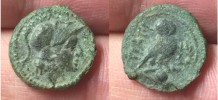
Apulia. TeateApulia, Teate, Uncia, c. 225-220 BC; AE; Head of Athena r., wearing crested Corinthian helmet, Rv. TIATI, owl standing r. with closed wings; below one pellet. Dotted border. HNItaly 702d; SNG Copenhagen -; SNG ANS 752.ecoli
|
|
|
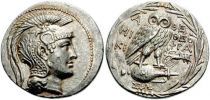
ATTICA, AthensATTICA, Athens. Circa 168/5-50 BC. AR New Style Tetradrachm (30mm, 16.74 gm). Struck circa 136/5 BC. Helmeted head of Athena right / A-QE, owl standing right on amphora; magistrates MI-KI and QEO-FRA; Nike in quadriga right in right field, M on amphora, SW below amphora; all within wreath. Cf. Thompson 315-323 (unlisted dies). EF, lightly toned. Ex -CNG STORE 895ecoli
|
|

Attica, AthensAthens, ca. 449-413 BC. Silver tetradrachm.
Denomination : Silver tetradrachm.
Size : 23.7 x 24.3 mm Weight : 17.20 grams.
Reference : Sear-2526.
Grade : gVF and better centered than usual with a significant part of the crest showing.
Obverse : Head of Athena right.
Reverse : Owl standing right, with an olive sprig and crescent moon over its shoulder, with a AQE to the right.
Ex-Calgary Coin 1150ecoli
|
|
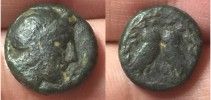
ATTICA, AthensATTICA, Athens. Circa 322/17-307 BC. Æ . Helmeted head of Athena right / Two owls confronted, heads facing; Eleusis ring between; all within olive wreath. Kroll 44; SNG Copenhagen 92. ecoli
|
|

ATTICA, AthensATTICA, Athens. Circa 322/17-307 BC. Æ (15mm, 2.26 g, 6h). Helmeted head of Athena right / Two owls standing confronted, heads facing; AΘ between; all within wreath. Kroll 46; HGC 4, 1726. ecoli
|
|

ATTICA, AthensATTICA, Athens. Circa 335-322/17 BC. Æ Dichalkon (1.85 g, 1h). Helmeted head of Athena right / Double-bodied owl standing, bodies confronted, head facing; crescent and olive-sprig above. Kroll 43; SNG Copenhagen 72-3.ecoli
|
|

Attica, AthensATTICA, Athens. Circa 25-19 BC. Æ (17mm, 7.96 g, 12h). Helmeted head of Athena right / Sphinx seated right, wearing modius; all within olive wreath. Kroll 153; SNG Copenhagen 303; Svoronos pl. 80, 18-21.
ecoli
|
|

Batria, Oriental GreekApollodotos I Soter.
Apollo standing facing, head left, holding arrow and bow / Tripod; monogram to right. Bopearachchi 6K; SNG ANS -ecoli
|
|

BOEOTIA, ThebesIn the late 6th century BC the Thebans were brought for the first time into hostile contact with the Athenians, who helped the small village of Plataea to maintain its independence against them, and in 506 repelled an inroad into Attica. The aversion to Athens best serves to explain the unpatriotic attitude which Thebes displayed during the Persian invasion of Greece (480–479 BC). Though a contingent of 700 was sent to Thermopylae and remained there with Leonidas until just before the last stand when they surrendered to the Persians[1], the governing aristocracy soon after joined King Xerxes I of Persia with great readiness and fought zealously on his behalf at the battle of Plataea in 479 BC. The victorious Greeks subsequently punished Thebes by depriving it of the presidency of the Boeotian League, and an attempt by the Spartans to expel it from the Delphic amphictyony was only frustrated by the intercession of Athens.
In 457 Sparta, needing a counterpoise against Athens in central Greece, reversed her policy and reinstated Thebes as the dominant power in Boeotia. The great citadel of Cadmea served this purpose well by holding out as a base of resistance when the Athenians overran and occupied the rest of the country (457–447). In the Peloponnesian War the Thebans, embittered by the support which Athens gave to the smaller Boeotian towns, and especially to Plataea, which they vainly attempted to reduce in 431, were firm allies of Sparta, which in turn helped them to besiege Plataea and allowed them to destroy the town after its capture in 427 BC. In 424 at the head of the Boeotian levy they inflicted a severe defeat upon an invading force of Athenians at the Battle of Delium, and for the first time displayed the effects of that firm military organization which eventually raised them to predominant power in Greece.
After the downfall of Athens at the end of the Peloponnesian War the Thebans, finding that Sparta intended to protect the states which they desired to annex, broke off the alliance. In 404 they had urged the complete destruction of Athens, yet in 403 they secretly supported the restoration of its democracy in order to find in it a counterpoise against Sparta. A few years later, influenced perhaps in part by Persian gold, they formed the nucleus of the league against Sparta. At the battles of Haliartus (395) and Coronea (394) they again proved their rising military capacity by standing their ground against the Spartans. The result of the war was especially disastrous to Thebes, as the general settlement of 387 stipulated the complete autonomy of all Greek towns and so withdrew the other Boeotians from its political control. Its power was further curtailed in 382, when a Spartan force occupied the citadel by a treacherous coup-de-main. Three years later the Spartan garrison was expelled, and a democratic constitution definitely set up in place of the traditional oligarchy. In the consequent wars with Sparta the Theban army, trained and led by Epaminondas and Pelopidas, proved itself the best in Greece. Some years of desultory fighting, in which Thebes established its control over all Boeotia, culminated in 371 in a remarkable victory over the pick of the Spartans at Leuctra. The winners were hailed throughout Greece as champions of the oppressed. They carried their arms into Peloponnesus and at the head of a large coalition permanently crippled the power of Sparta. Similar expeditions were sent to Thessaly and Macedon to regulate the affairs of those regions.
However the predominance of Thebes was short-lived; the states which she protected refused to subject themselves permanently to her control, and the renewed rivalry of Athens, which had joined with Thebes in 395 in a common fear of Sparta, but since 387 had endeavoured to maintain the balance of power against her ally, prevented the formation of a Theban empire. With the death of Epaminondas at Mantinea in 362 the city sank again to the position of a secondary power. In a war with the neighbouring state of Phocis (356–346) it could not even maintain its predominance in central Greece, and by inviting Philip II of Macedon to crush the Phocians it extended that monarch's power within dangerous proximity to its frontiers. A revulsion of feeling was completed in 338 by the orator Demosthenes, who persuaded Thebes to join Athens in a final attempt to bar Philip's advance upon Attica. The Theban contingent lost the decisive battle of Chaeronea and along with it every hope of reassuming control over Greece. Philip was content to deprive Thebes of her dominion over Boeotia; but an unsuccessful revolt in 335 against his son Alexander was punished by Macedon and other Greek states by the severe sacking of the city, except, according to tradition, the house of the poet Pindar.
BOEOTIA, Thebes. Circa 395-338 BC. AR Stater (21mm, 11.98 gm). Boeotian shield / Amphora; magistrate AM-FI. Hepworth, "The 4th Century BC Magistrate Coinage of the Boiotian Confederacy," in Nomismatika Xronika (1998), 2; BMC Central Greece -. Fine.
Ex-Cng eAuction 105, Lot: 34 225/200
ecoli
|
|

BRUTTIUM, PeteliaBRUTTIUM, Petelia. Circa 214-212 BC. Æ 20mm
Veiled head of Demeter right / [PETHLINWN], Zeus standing left, head reverted, holding thunderbolt and sceptre; star to left, F to right. Caltabiano, Petelia 3; SNG ANS 602 var. (N not F); HN Italy 2454.ecoli
|
|

BRUTTIUM, RhegionBRUTTIUM, Rhegion. Circa 415/0-387 BC. Æ 11mm . Lion's head facing /laureate head of Apollo right. Cf. SNG ANS 702; HN Italy 2524ecoli
|
|

Bruttium, Vibo Valentia (later Hipponium)Vibo Valentia (later Hipponium), Bruttium, AE19 Semis. Ca. 192-89 BC. Diademed head of Hera right, S behind head / VALENTIA to left of two cornucopiae, S and krater in right field. BMC 15; SNG Cop 1842.ecoli
|
|

CALABRIA, TarentumTaranto was founded in 706 BC by Dorian immigrants as the only Spartan colony, and its origin is peculiar: the founders were Partheniae, sons of unmarried Spartan women and perioeci (free men, but not citizens of Sparta); these unions were decreed by the Spartans to increase the number of soldiers (only the citizens of Sparta could become soldiers) during the bloody Messenian Wars, but later they were nullified, and the sons were forced to leave. According to the legend Phalanthus, the Parthenian leader, went to Delphi to consult the oracle and received the puzzling answer that he should found a city where rain fell from a clear sky. After all attempts to capture a suitable place to found a colony failed, he became despondent, convinced that the oracle had told him something that was impossible, and was consoled by his wife. She laid his head in her lap and herself became disconsolate. When Phalanthus felt her tears splash onto his forehead he at last grasped the meaning of the oracle, for his wife's name meant clear sky. The harbour of Taranto in Apulia was nearby and he decided this must be the new home for the exiles. The Partheniae arrived and founded the city, naming it Taras after the son of the Greek sea god, Poseidon, and the local nymph Satyrion. A variation says Taras was founded in 707 BC by some Spartans, who, the sons of free women and enslaved fathers, were born during the Messenian War. According to other sources, Heracles founded the city. Another tradition indicates Taras himself as the founder of the city; the symbol of the Greek city (as well as of the modern city) is Taras riding a dolphin. Taranto increased its power, becoming a commercial power and a sovereign city of Magna Graecia, ruling over the Greek colonies in southern Italy.
In its beginning, Taranto was a monarchy, probably modelled on the one ruling over Sparta; according to Herodotus (iii 136), around 492 BC king Aristophilides ruled over the city. The expansion of Taranto was limited to the coast because of the resistance of the populations of inner Apulia. In 472 BC, Taranto signed an alliance with Rhegion, to counter the Messapii, Peuceti, and Lucanians (see Iapygian-Tarentine Wars), but the joint armies of the Tarentines and Rhegines were defeated near Kailìa (modern Ceglie), in what Herodotus claims to be the greatest slaughter of Greeks in his knowledge, with 3,000 Reggians and uncountable Tarentines killed. In 466 BC, Taranto was again defeated by the Iapyges; according to Aristotle, who praises its government, there were so many aristocrats killed that the democratic party was able to get the power, to remove the monarchy, inaugurate a democracy, and expel the Pythagoreans. Like Sparta, Tarentum was an aristocratic republic, but became democratic when the ancient nobility dwindled.
However, the rise of the democratic party did not weaken the bonds of Taranto and her mother-city Sparta. In fact, Taranto supported the Peloponnesian side against Athens in the Peloponnesian War, refused anchorage and water to Athens in 415 BC, and even sent ships to help the Peloponnesians, after the Athenian disaster in Sicily. On the other side, Athens supported the Messapians, in order to counter Taranto's power.
In 432 BC, after several years of war, Taranto signed a peace treaty with the Greek colony of Thurii; both cities contributed to the foundation of the colony of Heraclea, which rapidly fell under Taranto's control. In 367 BC Carthage and the Etruscans signed a pact to counter Taranto's power in southern Italy.
Under the rule of its greatest statesman, strategist and army commander-in-chief, the philosopher and mathematician Archytas, Taranto reached its peak power and wealth; it was the most important city of the Magna Graecia, the main commercial port of southern Italy, it produced and exported goods to and from motherland Greece and it had the biggest army and the largest fleet in southern Italy. However, with the death of Archytas in 347 BC, the city started a slow, but ineluctable decline; the first sign of the city's decreased power was its inability to field an army, since the Tarentines preferred to use their large wealth to hire mercenaries, rather than leave their lucrative trades.
In 343 BC Taranto appealed for aid against the barbarians to its mother city Sparta, in the face of aggression by the Brutian League. In 342 BC, Archidamus III, king of Sparta, arrived in Italy with an army and a fleet to fight the Lucanians and their allies. In 338 BC, during the Battle of Manduria, the Spartan and Tarentine armies were defeated in front of the walls of Manduria (nowadays in province of Taranto), and Archidamus was killed.
In 333 BC, still troubled by their Italic neighbours, the Tarentines called the Epirotic king Alexander Molossus to fight the Bruttii, Samnites, and Lucanians, but he was later (331 BC) defeated and killed in the battle of Pandosia (near Cosenza). In 320 BC, a peace treaty was signed between Taranto and the Samnites. In 304 BC, Taranto was attacked by the Lucanians and asked for the help of Agathocles tyrant of Syracuse, king of Sicily. Agathocles arrived in southern Italy and took control of Bruttium (present-day Calabria), but was later called back to Syracuse. In 303 BC-302 BC Cleonymus of Sparta established an alliance with Taranto against the Lucanians, and fought against them.
Arnold J. Toynbee, a classical scholar who taught at Oxford and other prestigious English universities and who did original and definitive work on Sparta (e.g. The Journal of Hellenic Studies, vol. xxxiii 1913 p. 246-275) seemed to have some doubts about Tarentum (Taranto) being of Spartan origin.
In his book The Study of History vol. iii p. 52 he wrote: "...Tarentum, which claimed a Spartan origin; but, even if this claim was in accordance with historical fact..." The tentative phrasing seems to imply that the evidence is neither conclusive or even establishes a high degree of probability of the truth that Tarentum (Taranto) was a Spartan colony.
CALABRIA, Tarentum. Circa 302-281 BC. AR Drachm (17mm, 2.91 gm). Helmeted head of Athena right, helmet decorated with Skylla hurling a stone / Owl standing right head facing, on olive branch; Vlasto 1058; SNG ANS 1312; HN Italy 1015. VF.
Ex-Cng eAuction 103 Lot 2 190/150ecoli
|
|

CALABRIA. Tarentum. Circa 280-272 BCAR drachm (15mm, 3.17g). .
Helmeted head of Athena left; helmet decorated with Skylla hurling a stone / Owl standing right on thunderbolt, wings spread. Vlasto 1077ff.ecoli
|
|

CAMPANIA, NeapolisCAMPANIA, Neapolis. Circa 300-275 BC. AR Nomos (18mm, 7.06 g, 5h). Head of nymph right; X behind / Man-headed bull walking right; above, Nike flying right, placing wreath on bull's head; EYΞ below. Sambon 477; HN Italy 579; SNG ANS 370. Fine, toned,ecoli
|
|

Caria, Kaunos CARIA, Kaunos. Circa 350-300 BC. Forepart of a bull right / Sphinx seated right. SNG Keckman 70.ecoli
|
|

Caria, Kos
CARIA. Kos. Ae (Circa 250-210 BC). Anaxip-, magistrate. Obv: Head of Herakles right, wearing lion skin. Rev: ΚΩΙ / ΑΝΑΞΙΠ. Crab. SNG von Aulock 2755 var. (magistrate); HGC 6, 1338. ecoli
|
|
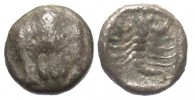
Caria, MylasaCaria, Mylasa. 450-400 B.C. AR obol (7.5 mm, 0.49 g, 6 h). Facing forepart of lion / Scorpion, tail to right; within incuse square. SNG Kayhan 934-938; SNG von Aulock 7803. Fine.ecoli
|
|

Caria, MylasaCARIA, Mylasa(?). Circa 420-390 BC. AR Tetartemorion (5mm, 0.18 g, 9h). Forepart of lion left, head right / Bird standing right; pellet to upper left and lower right; all within incuse square. SNG Keckman 922–3; SNG Kayhan 944–6; SNG von Aulock 1818; SNG Copenhagen –; Klein 432 (Miletos; this coin). VF, toned, porosity, obverse poorly struck. From the Daniel Koppersmith Collection. Ex Elsen FPL 258 (October-December 2011), no. 62.ecoli
|
|

Caria, RhodosRhodos, Caria: AE 10mm / Rhodos
3rd-2nd century BC. Radiate head of Rhodos right, wearing stephane / Rose within incuse square. SNG Cop. 861v. Fine.
Ex-Saylesecoli
|
|

CARIA. Rhodos, RhodesISLANDS off CARIA. Rhodos, Rhodes. Circa 125-88 BC. AR Hemidrachm (14mm, 1.25 gm). Magistrate Melantas. Radiate head of Helios facing slightly right / P-O, rose; MELANTAS above, grape bunch to right; all within incuse square. Jenkins, Rhodian, Group D, Series 98; cf. SNG Helsinki 668; SNG Copenhagen -. Near EF. Ex-CNG(295) B127V127ecoli
|
|

CARTHAGECARTHAGE. Circa 400-350 BC. Æ 16mm (2.59 gm). Wreathed head of Tanit left, wearing pendant necklace / Horse standing right, palm behind; pellet above, trefoil of pellets before. Alexandropoulos 18f; SNG Copenhagen 119; Müller 167. Nice VF, green patina. Ex-CNG(77) B54V64ecoli
|
|

CARTHAGECARTHAGE. Circa 370-340 BC. Æ 13mm (1.37 gm). Sicilian mint. Wreathed male head left / Horse prancing right. Calciati III pg. 377, 4; SNG Copenhagen 98. VF, dark brown, green and red patina, some roughness. Scarce. EX-CNG B33V4B
ecoli
|
|

CarthageCarthage (3rd century BC). AE (18 mm / 4.90 g). Head of Tanit left / Horse head right, punic letter before. cf S 6525. Possibly overstruck on another coin, traces barely visible on obverse and reverse. Ex-Barry and Darling G15
Check
ecoli
|
|

Cilicia, Seleukeia.Cilicia, Seleukeia. 2nd-1st centuries B.C. Æ 18 mm (3.86 g, 11 h). Laureate head of Apollo right; behind, monogram / [ΣEΛEVKEΩN] TΩN Î POΣ TΩI KAΛVKAΔN[OI], forepart of horse right; below, two monograms. Cf. SNG BN 917-28; cf. SNG Levante 690-8; cf. SNG Levante suppl. 181-3; cf. SNG von Aulock 5810-3 (all with diff. monograms).
Checkecoli
|
|

Cilicia, Tarsos. MazaiosCilicia, Tarsos. Mazaios. Satrap of Cilicia, 361/0-334 B.C. AR stater (24.30 mm, 10.76 g, 7 h). Baaltars seated left, holding eagle, grain ear, grape bunch and scepter / Lion attacking bull to left. SNG France 340; SNG Levante 102. gVF, a few scratches.ecoli
|
|

Cimmerian Bosporos, PhanagoreiaCIMMERIAN BOSPOROS, Phanagoreia (as Agrippia). Circa 14-12 BC. Veiled head of Aphrodite right, wearing stephanos / Prow of galley left; H (mark of value) to right, three pellets below. MacDonald 275/4; RPC I 1935; HGC 7, –.ecoli
|
|

CorinthPegasus/tridentecoli
|
|

Corinth, Corinthia.Corinthia, Corinth. ca. 368-355 B.C. AE 13 (12.6 mm, 1.94 g, 8 h). Pegasos flying left; koppa below / Trident-head upward; Torch in fields. Cf. BCD 279-281ecoli
|
|

Corinth, Corinthia.Corinthia, Corinth. ca. 368-355 B.C. AE 13 (12.6 mm, 1.94 g, 8 h). Pegasos flying left; koppa below / Trident-head upward; wreath in fields. Cf. BCD 279-281ecoli
|
|

Corinth, Corinthia.Corinthia, Corinth. ca. 368-355 B.C. AE 13 (12.6 mm, 1.94 g, 8 h). Pegasos flying left; koppa below / Trident-head upward; Cf. BCD 279-281ecoli
|
|

Corinthia, Corinth Corinthia, Corinth. ca. 368-355 B.C. AE 13 (12.6 mm, 1.94 g, 8 h). Pegasos flying left; koppa below / Trident-head upward; wreath in fields. Cf. BCD 279-281 ecoli
|
|
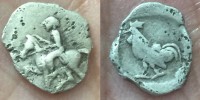
Dardanos, TroasDardanos, Troas. 4th-3rd centuries BC. AR Obol (9mm, 0.64 g). Horseman riding left / Cock standing left within incuse square. SNG Copenhagen 282.ecoli
|
|

Demetrios I PoliorketesKINGS of MACEDON. Demetrios I Poliorketes. 306-283 BC. Æ . Pella mint. Macedonian shield with monogram of Demetrios in central boss / Macedonian helmet. Newell 132; SNG Alpha Bank 969. ecoli
|
|

Dionysios I, Sicily, SyracuseSICILY, Syracuse. Dionysios I. 405-367 BC. Æ Drachm. Head of Athena left, wearing Corinthian helmet decorated with wreath / Sea-star between two dolphins. CNS 62; HGC 2, 1436.ecoli
|
|

DYNASTS of LYCIA. Uvug
DYNASTS of LYCIA. Uvug. Circa 470-440 BC. AR Tetrobol (15mm, 2.72 g, 1h). Forepart of winged man-headed bull right / Laureate male head right within dotted square border; all within incuse square. Falghera II 90-3; SNG von Aulock 4119; SNG Copenhagen Supp. 4301. VF, toned, some light porosity, struck from a worn obverse die.ecoli
|
|

Egypt, AlexandriaPtolemy VIII
145-116BC
AE24, 15.06G
SNG COP-334
Head of Alexander in elephant scalp
Eagle standing left on thunderbolt
ex Don Doswell collection
ex HJBecoli
|
|

Egypt, AlexandriaPtolemaic Kingdom, Ptolemy VI Philometor and Ptolemy VIII Euergetes II (Physcon), c. 170 - 164 B.C.
Two eagles in the reverse may symbolize joint ruleecoli
|
|

Egypt, AlexandriaPTOLEMAIC KINGS of EGYPT. Ptolemy II Philadelphos. 285-246 BC. Æ Alexandreia mint. Struck circa 260 BC. Deified head of Alexander the Great right, wearing elephant skin headdress / Eagle standing left on thunderbolt.ecoli
|
|
|

Gambrion, MysiaGambrion, Mysia, c. 350 - 300 B.C.
obverse laureate head of Apollo right;
reverse Γ-A-M between rays of star
Bronze AE 10, SGCV II 3871, BMC 2,ecoli
|
|

Histiaia, EuboiaThe history of the island of Euboea is largely that of its two principal cities, Chalcis and Eretria, both mentioned in the Catalogue of Ships. Both cities were settled by Ionian Greeks from Attica, and would eventually settle numerous colonies in Magna Graecia and Sicily, such as Cumae and Rhegium, and on the coast of Macedonia. This opened new trade routes to the Greeks, and extended the reach of western civilization. The commercial influence of these city-states is evident in the fact that the Euboic scale of weights and measures was used among the Ionic cities generally, and in Athens until the end of the 7th century BC, during the time of Solon.[citation needed] The classicist Barry B. Powell has proposed that Euboea may have been where the Greek alphabet was first employed, c. 775-750 BC, and that Homer may have spent part of his life on the island.
Chalcis and Eretria were rival cities, and appear to have been equally powerful for a while. One of the earliest major military conflicts in Greek history took place between them, known as the Lelantine War, in which many other Greek city-states also took part. In 490 BC, Eretria was utterly ruined and its inhabitants were transported to Persia[clarification needed]. Though it was restored nearby its original site after the Battle of Marathon, the city never regained its former eminence.
Both cities gradually lost influence to Athens, which saw Euboea as a strategic territory. Euboea was an important source of grain and cattle, and controlling the island meant Athens could prevent invasion and better protect its trade routes from piracy.
Athens invaded Chalcis in 506 BC and settled 4,000 Attic Greeks on their lands. After this conflict, the whole of the island was gradually reduced to an Athenian dependency. Another struggle between Euboea and Athens broke out in 446. Led by Pericles, the Athenians subdued the revolt, and captured Histiaea in the north of the island for their own settlement.
By 410 BC, the island succeeded in regaining its independence. Euboea participated in Greek affairs until falling under the control of Philip II of Macedon after the Battle of Chaeronea in 338 BC, and eventually being incorporated into the Roman Republic in the second century BC. Aristotle died on the island in 322 BC soon after fleeing Athens for his mother's family estate in Chalcis.
Tetrobol, 275-225 BC, Sear (GC) 2496
Obv: Anepigraphic. Head of the nymph, Histiaia, right, wearing wreath of vine and hair rolled.
Rev: ΙΣΤΙΑΙΕΩΝ
The nymph Histiaia seated right on stern of galley and holding naval standard.
Ebay ecoli
|
|

Illyria, DyrrhachiumGR2. Illyria, Dyrrhachium. After 229 BC. Silver drachm
Obverse : Cow with suckling calf,and the moneyers name MENISKOS above the cow's back, with a small eagle above the name.
Reverse : Double star pattern in a square, with an inscription naming the city around.
In 229 BCE, when the Romans seized the city the "-damnos" part of the name was inauspicious to Latin ears, and its name, as it was refounded, became Dyrrhachium. Pausanias (6.x.8) says "the modern Roman city is not the ancient one, being at a short distance from it. The modern city is called Dyrrhachium from its founder." The name Dyrrachion is found on coins of the fifth century BCE; in the Roman period Dyrrachium was more common. However, the city maintained a semi-autonomy and was turned into a Roman colony.
Dyrrachium was the landing place for Roman passengers crossing the Ionian Sea from Brundisium, which made it a fairly busy way-station. Here commenced the Via Egnatia, the Roman military road to Thessalonica that connected Roman Illyria with Macedonia and Thrace. The city itself was part of Macedonia, more specifically Epirus Nova. In 48 BCE Pompey was based at Dyrrachium and beat off an attack by Julius Caesar (see Battle of Dyrrhachium). In 345 BCE the city was levelled by an earthquake and rebuilt on its old foundations. In the 4th century CE, Dyrrachium was made the capital of the Roman province of Epirus nova.
The name "Epidamnos" was still used by the Byzantines, as for example in the 13th-century Synopsis Chronike, referring to contemporary events.
ecoli
|
|

Indo-Greek Kings of Bactria, MenanderIndo-Greek Kings of Bactria, Menander, 160-145 BC, Square AE16 (2.76gm), Pushkalavati. Rare.
O: BASILEWS SWTEROS MENANDROU. Head of Pallas r., wearing plumed helmet. R: Karosthi legend. Maharajasa tratarasa Menadrasa. Nike adv. r., holding wreath and palm; Pushkalavati monogram below. Cf. MA 1821-1823 (but dichalkon). VF, glossy dark green patina. G22
ecoli
|
|

INDO-GREEK, Eukratides IHelmeted bust of king right, Greek legend around: BAΣIΛEΩΣ / MEΓAΛOY / EYKPATIΔOY
Reverse Dioscuri on horseback right, Kharoshthi legend around: Maharajasa / Evukratidasa, no monogram
Date c. 171-145 BCEecoli
|
|

INDO-GREEK, Eukratides I Helmeted bust of king right, Greek legend around: BAΣIΛEΩΣ / MEΓAΛOY / EYKPATIΔOY
Reverse Dioscuri on horseback right, Kharoshthi legend around: Maharajasa / Evukratidasa, no monogram
Date c. 171-145 BCEecoli
|
|

Indo-Greek: Apollodotus I Apollo standing facing, holding arrow in right hand and bow in left, no monogram at left, Greek legend around: BAΣIΛEΩΣ / AΠOΛΛOΔOTOY / ΣΩTHPOΣ
Tripod with monogram at right, within square dotted border, Kharoshthi legend around: Maharajasa / Apaladatasa / tratarasaecoli
|
|

INDO-SKYTHIANS. Zeionises Indo-Scythian satraps, Zeionises. HGC12-727. Uncertain mint in Chuksa.. Bull to the left, Elephant right.ecoli
|
|

Ionia, ColophonColophon (/ˈkɒləfɒn/;[1] Ancient Greek: Κολοφών) was an ancient city in Ionia. Founded around the turn of the first millennium BC, it was likely one of the oldest of the twelve cities of the Ionian League. In ancient times it was located between Lebedos (120 stadia to the west) and Ephesus (70 stadia to its south). Today the ruins of the city can be found south of the town Değirmendere Fev in the Menderes district of Izmir Province, Turkey.
The city's name comes from the word κολοφών, "summit", which is also the origin of the bibliographic term "colophon", in the metaphorical sense of a 'crowning touch', as it was sited along a ridgeline. The term "colophony" for rosin comes from the term colophonia resina, that is, resin from the pine trees of Colophon, which was highly valued for the strings of musical instruments.
Ionia, Colophon, c. 389-350 BC, 0.80g. ANSNNM 96, Milne, Kolophon-57. Obv: Head of Apollo l. Rx: Lyre. ecoli
|
|

IONIA, EphesosIONIA, Ephesos. 387-295 BC.
Female head left. /Greek letters on either side of bee. BMC 14, 55, 68-70; Sear 4409 .ecoli
|
|

IONIA, EPHESOS (Ephesus) IONIA, EPHESOS (Ephesus) AE 3rd century BC. Bee within laurel wreath Reverse, Stag grazing right,ecoli
|
|

Ionia, EphesusIonia, Ephesus c.390-330BC Silver Diobol
Obv: EΦ, Bee with straight wings, border of dots.
Rev: EΦ, Stag's heads facing.
SNG Copenhagen 242; SNG Kayhan 194f.ecoli
|
|

Ionia, KlazomenaiIonia, Klazomenai Ca. 375-340 BC. Æ 19mm
OBVERSE: Three-quarter facing head of Athena, head slightly right, in triple crested helmet decorated with olive branch, earrings & necklace.
REVERSE: Ram walking right; Trophy before
SNG Copenhagen 86
ecoli
|
|

Ionia, KolophonObverse: No Legend: Head of Apollo right, hair bound with taenia
Reverse: No Legend: Lyre.
Mint: KolophonMinted: 389-350bc
Ref: SNGvA-2008
ecoli
|
|

Ionia, Kolophon;IONIA, Kolophon. Circa 530/25-500 BC. AR Tetartemorion (5mm, 0.17 g). Archaic head of Apollo left / Incuse square punch. SNG Kayhan 343; SNG Copenhagen -. Near VF, toned and porous.ecoli
|
|

Ionia, MiletosIonia, Miletos, late 6th-early 4th century BC, AR 1/12th Stater (1.16 gm.). Obv.: Head lion left. Rev.: Star. SNG Helsinki II , 267. Attractive very fine. g23ecoli
|
|

IONIA, PhokaiaIONIA, Phokaia. Circa 521-478 BC. AR Hemihekte (9mm, 1.32 g). Head of nymph left, hair in plain sakkos / Quadripartite incuse square. SNG von Aulock 1815; SNG Copenhagen (Cyprus, etc.) 389–93. Good VF, toned. Fine archaic style.
Ex CNG eAuction 311, Lot 737 85/100
ecoli
|
|

IONIA, Phokaia
IONIA, Phokaia. Late 6th century BC. AR Tetartemorion (8mm, 0.12 g). Head of griffin left / Quadripartite incuse square. SNG von Aulock 7938 (head right); SNG Copenhagen Supp. 339 var. (same); Rosen 603 (same). VF, toned, porous. From the Daniel Koppersmith Collection. Ex Classical Numismatic Group Electronic Auction 263 (31 August 2011), lot 106.ecoli
|
|

IONIA, Phokaia.The ancient Greek geographer Pausanias says that Phocaea was founded by Phocians under Athenian leadership, on land given to them by the Aeolian Cymaeans, and that they were admitted into the Ionian League after accepting as kings the line of Codrus. Pottery remains indicate Aeolian presence as late as the 9th century BC, and Ionian presence as early as the end of the 9th century BC. From this an approximate date of settlement for Phocaea can be inferred.
According to Herodotus the Phocaeans were the first Greeks to make long sea-voyages, having discovered the coasts of the Adriatic, Tyrrhenia and Spain. Herodotus relates that they so impressed Arganthonios, king of Tartessus in Spain, that he invited them to settle there, and, when they declined, gave them a great sum of money to build a wall around their city.
Their sea travel was extensive. To the south they probably conducted trade with the Greek colony of Naucratis in Egypt, which was the colony of their fellow Ionian city Miletus. To the north, they probably helped settle Amisos (Samsun) on the Black Sea, and Lampsacus at the north end of the Hellespont (now the Dardanelles). However Phocaea's major colonies were to the west. These included Alalia in Corsica, Emporiae and Rhoda in Spain, and especially Massalia (Marseille) in France.
Phocaea remained independent until the reign of the Lydian king Croesus (circa 560–545 BC), when they, along with the rest of mainland Ionia, first, fell under Lydian control[8] and then, along with Lydia (who had allied itself with Sparta) were conquered by Cyrus the Great of Persia in 546 BC, in one of the opening skirmishes of the great Greco-Persian conflict.
Rather than submit to Persian rule, the Phocaeans abandoned their city. Some may have fled to Chios, others to their colonies on Corsica and elsewhere in the Mediterranean, with some eventually returning to Phocaea. Many however became the founders of Elea, around 540 BC.
In 500 BC, Phocaea joined the Ionian Revolt against Persia. Indicative of its naval prowess, Dionysius, a Phocaean was chosen to command the Ionian fleet at the decisive Battle of Lade, in 494 BC. However, indicative of its declining fortunes, Phocaea was only able to contribute three ships, out of a total of "three hundred and fifty three". The Ionian fleet was defeated and the revolt ended shortly thereafter.
After the defeat of Xerxes I by the Greeks in 480 BC and the subsequent rise of Athenian power, Phocaea joined the Delian League, paying tribute to Athens of two talents. In 412 BC, during the Peloponnesian War, with the help of Sparta, Phocaea rebelled along with the rest of Ionia. The Peace of Antalcidas, which ended the Corinthian War, returned nominal control to Persia in 387 BC.
In 343 BC, the Phocaeans unsuccessfully laid siege to Kydonia on the island of Crete.
During the Hellenistic period it fell under Seleucid, then Attalid rule. In the Roman period, the town was a manufacturing center for ceramic vessels, including the late Roman Phocaean red slip.
It was later under the control of Benedetto Zaccaria, the Genoan ambassador to Byzantium, who received the town as a hereditary lordship; Zaccaria and his descendants amassed a considerable fortune from his properties there, especially the rich alum mines. It remained a Genoese colony until it was taken by the Turks in 1455. It is a titular see of the Roman Catholic Church.
IONIA, Phokaia. Circa 521-478 BC. AR Hemidrachm (9mm, 1.54 g). Head of griffin left / Quadripartite incuse square. SNG Copenhagen –; SNG von Aulock 2116; SNG Kayhan 512-6. VF, dark toning. ecoli
|
|

IONIA, TeosIONIA, Teos. Circa 450-425 BC. AR Hemitritemorion (6mm, 0.14 g). Forepart of griffin right / Quadripartite incuse square. Matzke Group Cb7-3, 103 (this coin); Balcer -; SNG Copenhagen -; MACW 77. Near VF, toned, some porosity. From the Daniel Koppersmith Collection. Ex Elsen FPL 206 (November-December 1999), no. 69P.
ecoli
|
|

Judea Alexander Jannaeus Alexander Janneus 103-76 BC
Obv: Hebrew Inscription (Yehonatan the High Priest and the Council of the Jews) surrounded by wreath.
Rev: Double cornucopia adorned with ribbons, pomegranate between horns.
ecoli
|
|
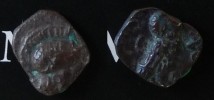
Judean imitation of athenian owlJudean imitation of Athenian owl, probably an obolecoli
|
|
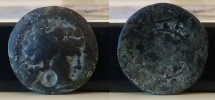
KallatisOBVERSE: Bust of Apollo right, counter mark of uncertain deity? below chin.
REVERSE: KALLA above wreath with mongram within ecoli
|
|

Katane, SicilySicily, Katane, c. 405-402 BC. Æ Litra (27mm, 13.55g, 10h). Wreathed head of Arethusa l.; two dolphins before. R/ Man-headed bull standing r. CNS III, 3; HGC 2, 616. Rare. Green patina, Good Fineecoli
|
|

Kings of Macedon KINGS of MACEDON. Alexander III ‘the Great’. 336-323 BC. Æ 1/2 Unit Uncertain mint in Macedon. Possible lifetime issue, struck under Antipater, Polyperchon, or Kassander, circa 325-310 BC. Macedonian shield, boss decorated with thunderbolt between two pellets / Macedonian helmet; Δ below. Price 417.ecoli
|
|
|
|

|
